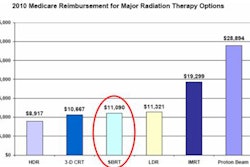When brain cancer recurs after initial treatment, patients know they face near-term death. But those who receive hypofractionated stereotactic radiation therapy (RT) to treat recurrent high-grade gliomas have expected survival of almost a year, on average, according to researchers from Thomas Jefferson University Hospital in Philadelphia.
The team also found that patients will experience few toxicities from the treatment. Based on the results of nearly 150 patients treated between 1994 and 2008, radiation oncologists at the hospital's Kimmel Cancer Center recommend that hypofractionated stereotactic RT be considered standard salvage therapy for previously irradiated high-grade gliomas, even for patients whose tumors recur within six months of initial treatment (Journal of Clinical Oncology, May 17, 2010).
Stereotactic radiation therapy delivers precise radiation dose to a tumor while decreasing the dose to surrounding tissue. Fractionated stereotactic radiation therapy is less toxic for patients than single-fraction stereotactic RT, and hypofractionated stereotactic RT condenses treatment to a two-week time period instead of three to four weeks.
Shannon Fogh, MD, chief resident in radiation oncology and lead author of the article, said that the retrospective review was conducted to determine the efficacy and toxicity profile of the treatment by itself or in addition to repeat craniotomy or concomitant chemotherapy.
The authors identified 147 patients with either grade 3 astrocytoma or glioblastoma multiforme with tumor progression. All of the patients initially had neurosurgery, and 60% had re-resection prior to salvage radiation therapy. Patients received daily fractions of 3.5 Gy with a median dose of 35 Gy, and all patients were able to complete their treatment.
With the exception of one patient who received a radiation dose of 40 Gy, and who experienced severe headaches four months later, none of the patients experienced any clinically significant acute morbidity.
The median survival time from the start of radiation therapy was 10 months for patients with grade 3 tumors and 11 months for patients with grade 4 tumors. Fogh and colleagues identified younger age, smaller gross tumor volume, and shorter time between diagnosis and recurrence as factors associated with improved survival. Neither surgical resection nor concurrent chemotherapy provided any additional significant benefit.
"A shortened treatment course is not only more beneficial to patients with respect to quality of life and convenience, but may also represent a significant decrease in cost associated with re-treatment," she said. Fogh also pointed out that eliminating chemotherapy could also reduce treatment cost as well as related toxicities.
The findings of 15 years of data support the recommendation that all patients who are healthy enough to undergo radiation therapy -- and who have progressive high-grade gliomas that would benefit from salvage RT -- should be considered for hypofractionated stereotactic radiation therapy, according to senior author Maria Werner-Wasik, MD, a professor of radiation oncology at Jefferson Medical College and co-director of the stereotactic radiosurgery program at Jefferson Hospital for Neuroscience.
In the U.S., approximately three people out of every 100,000 are diagnosed each year as having a malignant glioma. For most of them, the cancer eventually recurs after primary treatment.
By Cynthia E. Keen
AuntMinnie.com staff writer
June 16, 2010
Related Reading
Radiation therapy has good outcomes for pediatric glioma patients, November 2, 2009
Can VMAT top IMRT for glioma treatment? September 18, 2009
Cognitive deficits seen with radiotherapy for low-grade glioma, August 11, 2009
FDG-PET changes treatment plans for glioma patients, June 26, 2008
Stereotactic radiosurgery can extend survival in small recurrent glioblastomas, June 20, 2008
Copyright © 2010 AuntMinnie.com



















